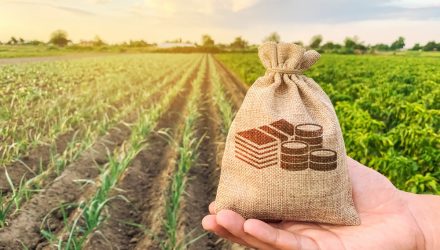Food and energy are excluded from the “core” inflation reading, but prices of both are soaring so dramatically that consumers don’t have time nor tolerance for economist lingo.
That is to say, food prices are far too high, and when that reverses course is anyone’s guess. For investors, there are ways to capitalize on this ominous trend. These include the VanEck Vectors Agribusiness ETF (MOO). MOO instead simply answers the question about food inflation and its investment implications. The VanEck exchange traded fund is up nearly 10% year-to-date, while the S&P 500 is lower by 5%.
“There is not necessarily one single market environment best for the agricultural industry as a whole,” says Coulter Regal, VanEck associate product manager. “The industry is broad, and companies operating within different segments of agribusiness may at times perform better or worse than others depending on the prevailing environment. For example, in an environment where short-term crop prices are rising, farmers will want to plant more crops, which may be good for chemicals and equipment manufacturers but bad for segments that buy crops for feed.”
While MOO can potentially perform well across various market settings, there’s no denying that 2022 is something of a perfect storm for the ETF. Agribusiness companies are often engaged in the production of or in assisting the output of agricultural commodities – an asset class that’s historically positively correlated to inflation.
Additionally, Russia’s war against Ukraine creates shortfalls of some agricultural commodities while leading to elevated fertilizer prices. The latter point is relevant to MOO investors because the fund is home to several fertilizer producers.
MOO, which tracks the MVIS® Global Agribusiness Index (MVMOOTR), is home to 54 stocks. That portfolio runs the gamut of fertilizer and seed producers, manufacturers of farm equipment, animal healthcare stocks, and more.
Beyond the high inflation and geopolitical conflict controlling headlines this year, MOO has a compelling, longer-ranging case.
“At a high level, the rationale for investing in agribusiness is relatively straightforward. As populations continue to grow, so does the need to increase agriculture production. The United Nations (UN) expects the global population to increase by 25% from 7.8 billion today to nearly 10 billion by the year 2050,” concludes Regal. “Aside from mounting global population, shifts in consumer preferences and a growing middle class also demand drivers. The UN estimates that it may take as much as 70% more food production to feed this larger and wealthier population in the coming decades compared to 2015.”
For more news, information, and strategy, visit the Beyond Basic Beta Channel.
The opinions and forecasts expressed herein are solely those of Tom Lydon, and may not actually come to pass. Information on this site should not be used or construed as an offer to sell, a solicitation of an offer to buy, or a recommendation for any product.







